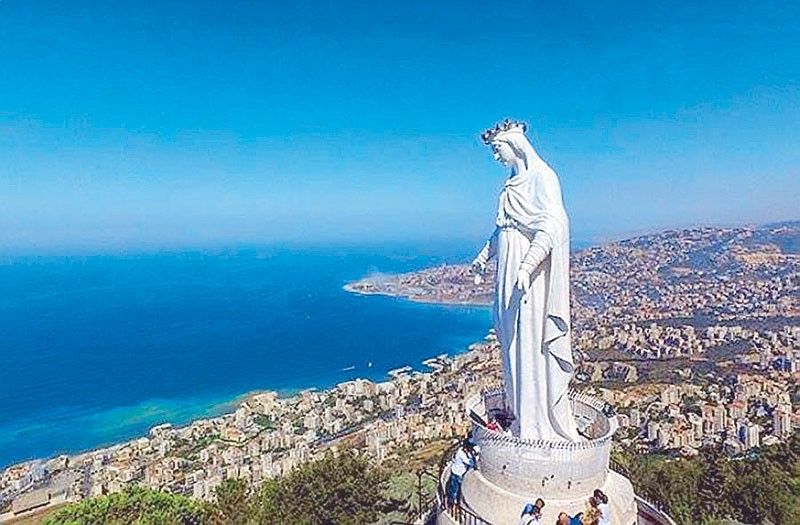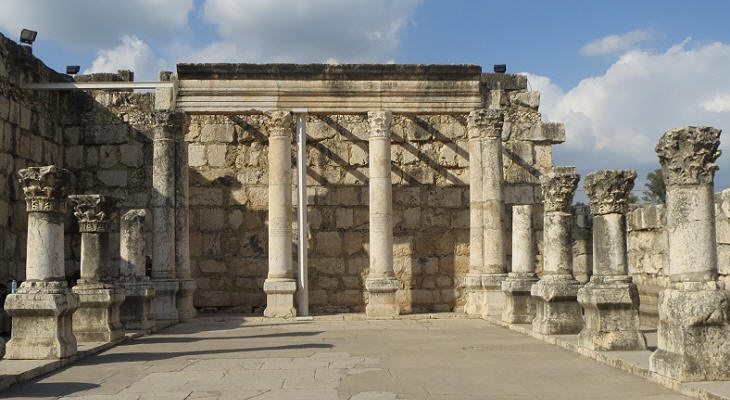 |
| Shrine of Our Lady of Lebanon, Harissa, courtesy, PhilStar.com |
Before the introduction of Christianity to Lebanon, the Phoenicians, as with most ancient peoples of the time, were pagans. During this period, Phoenicia was never a single unified country, but was made up of four main autonomous city-states, each ruled by their own kings, the two leading city-states being Tyre and Sidon. Byblos and Arwad were next in importance (see Byblos). During the reigns of David and Solomon in Israel, both Tyre and Sidon had mixed Israelite and Phoenician populations even though they were often ruled by Phoenician kings. Sometimes, the kings themselves even had mixed ancestry, for example King Hiram of Tyre who assisted King Solomon in building the Temple in Jerusalem. The following is a list of the ancient Phoenician kings centered in Tyre:
Agenor
(ruled from c. 1500 BCE), Phoenix, Eri-Aku, Abi-Milku, Aribas, Baal Termeg,
Baal, Pummay, (the list of the next century is unclear and it is resumed again
in the early 10th century BCE when Sidon, which was formerly ruled
by Ahiram, joined Tyre to form a union, but the kings continued to rule from
Tyre), Abibaal, Hiram I, Baal Eser I, Abdastartus, Astartus, Deleastartus,
Astarymus, Phelles, Itobaal I, Baal Eser II, Mattan I, Pygmalion;
Under
Assyrian rule - Itobaal
II, Hiram II, Mattan II, Itobaal III who ruled an independent Tyre;
Babylonian
rule - Baal II,
Yakinbaal, (monarchy overthrown in favor of judges), Chelbes, Abbar, Mattan III
and Ger Ashtari jointly, Baal Eser III, Hiram III who restored the monarchy;
Persian
rule - Mattan IV,
Boulomenus, Abdemon, the Cypriot Evagoras of Salamis who briefly united Tyre
with Cyprus, Eugoras, Azemilcus who reigned during the siege of Alexander the
Great, Abdolunim.
Thereafter,
the territory of Tyre alternated between Greek and Roman rule.
According to
some histories, Saint Peter was the first to evangelize the Phoenicians whom
he affiliated to the ancient patriarchate of Antioch. Paul
also preached in Lebanon, having lingered with the early Christians in Tyre and Sidon. Even though
Christianity was introduced early to Lebanon, its spread was very slow,
particularly in the mountainous areas where paganism was
still unyielding.
The earliest indisputable
tradition of Christianity in Lebanon can be traced back to Saint Maron in
the 4th century AD, being of Greek/Eastern/Antiochian Orthodox origin and the
founder of national and ecclesiastical Maronitism. Saint Maron adopted an
ascetic and reclusive life on the banks of the Orontes river in the vicinity
of Homs,
Syria and
founded a community of monks which began to preach the gospel in the
surrounding areas.
After the
Arab conquest and occupation in the 7th century, Saint John Maron, a
monk of Sarmin in Syria, led his followers
to the Lebanese mountains to the
village of Kfar Hai and there,
consolidated Lebanon’s Maronite heritage, often protected by the Marada
warriors who were also Maronites. The following is a list of the patriarchs since
his time (Druze leaders will be covered in a different posting):
John
Maron, Kyros, Gabriel, John Maron II (transferred the patriarchal seat to Yanouh then to Byblos), Youhanna,
Gregorius, Stefanos, Mark, Eusebius, Youhanna II, Yeshu, David, Gregorius II, Theophilactus,
Yeshu II, Domitius, Ishaq, Youhanna III, Shamun, Urmia, Youhanna IV, Shamun II,
Shamun III;
Crusader
period (1099-1305)
– (During the Crusades, the Maronites went into communion with the Roman
Catholic Church.) Yousef al Jirjisi, Butros (the patriarchate briefly moved to
the town of Mayfuq but then returned
to Byblos), Gregorius, Yacoub, Youhanna V, Boutros II, Boutros III, Boutros IV,
Urmia Amchiti, Daniel, Youhanna VI, Shamun IV, Yacoub II, Daniel II, Luqa and Urmia
III (the two patriarchs, ruling at the same time, caused a schism in the church
but it reunified after the death of Urmia in 1297), Shamun V succeeded and led
the Maronites into the:
Mameluke
Egyptian period (1305-1516)
- Shamun V, Youhanna VII, Gabriel II, David II, Youhanna el Jaji (transferred
the patriarchal seat to Kannoubine),
Yacoub el Hadathi, Yousef el Hadathi;
Ottoman
Turkish period (1516-1918)
- Seman el Hadathi, Mousa Saade el Akari, Mikhail al Rizzi, Sarkis el Rizzi,
Yousef el Rizzi, Youhanna Makhlouf, Gewargios Omaira al Duwaihi, Yousef Halib
el Akouri, Youhanna el Bawab, Gerges Beseb’eli, Estafanos el Duwaihi, Jibrail
II, Yacoub Awad, Yousef V el Khazen, Seman Awad, Tobias el Khazen, Yousef Estefan,
Mikhail Fadel, Philip Gemayel, Yousef Tyan, Youhanna Helou, Yousef Hobaish
(moved the patriarchal seat to Bkerke),
Yousef IX el Khazen, Boulos Massad, Youhanna el Hajj, Elias Peter Hoayek led
the Maronites from Ottoman to French rule after WWI;
French
rule (1918-1943) –
Elias Peter Hoayek, Anthony Peter Arida (led from French rule to independence);
Independence – Anthony Peter Arida, Paul Peter
Meouchi, Nasrallah Boutros Sfeir, Bechara Boutros al Rahi (the present
incumbent).

